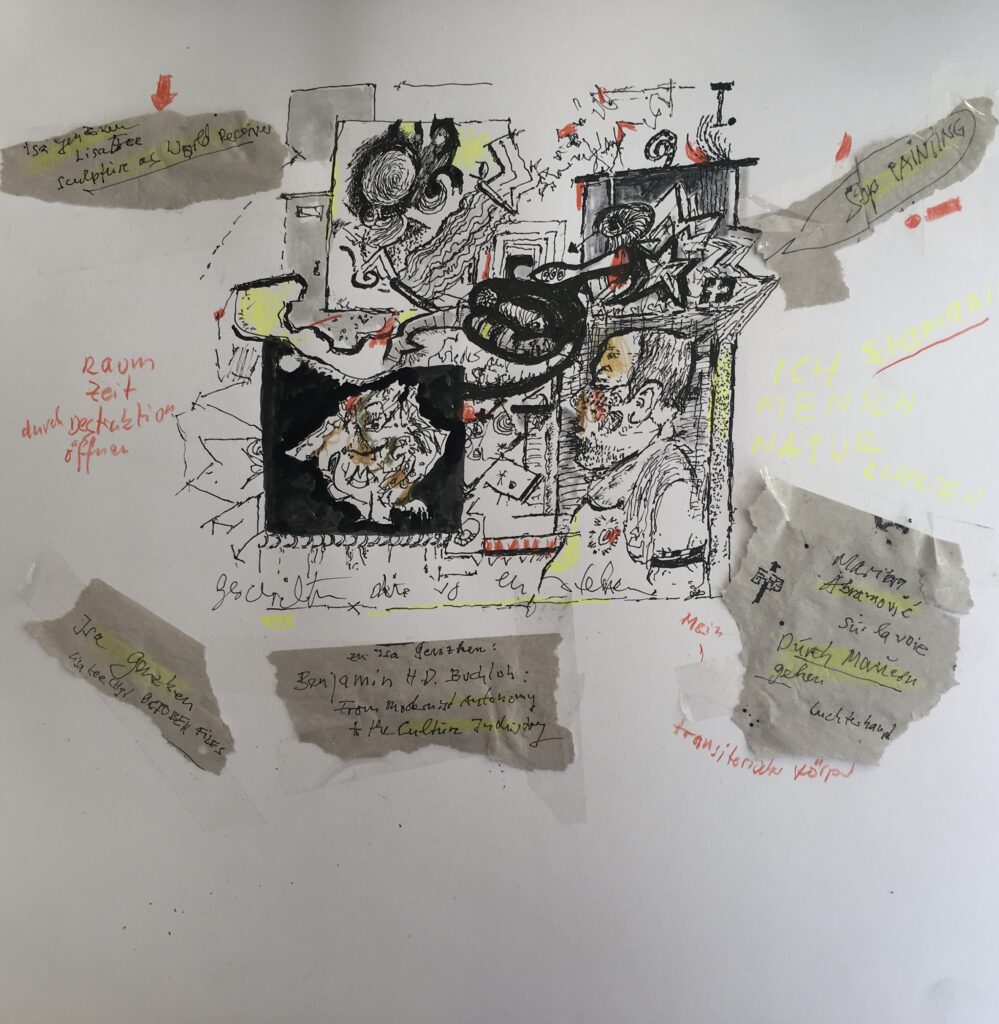©️Von Criegern, 2021
 ©️VonCriegern 2021
©️VonCriegern 2021
when I realized a couple of days before that when I started to cut the surface of my sculpture finer, strange things happened . What has been before a play of hills and valleys, tunnels and #vaults shifted to a tower of heads, arms, shoulders, faces and other #anatomic details. I was forced to go this way. In the evening I repeated this experience in a less complex way with pencil and paper. I „hammered“ the paper with pencil-strokes. A round form in the upper left corner #transformed ‚itself‘ in a face. I had no concept how to continue and this personal practice is supported by modern tendencies starting with the #collage of the early 20th century. And obviously the same happens with my sculpture. (By the way- after a visit of the excellent Peter Paul Rubens-Exposition at the Staatsgalerie Stuttgart, some 17th century details appeared in my drawing).
So what happens here? There are several things coming together. In the 19th century the art world lost its illusion of „true“ humanisme and realisme. We may also say the base of aristotelic esthetic. The summit of this development was reached with abstraction, focusing material and new ways of composition, #space #concepts, #harmony… OK, I love wood and I love to shape it. And the #human figure was already for the young student central subject. #Structure and round forms, texts and #illustrations were of high interest …
And what are these reflections good for? Today many artists are mainly fascinated of the possibility to express themselves in pure colours and completely #abstract or to follow trends like ‚#manga’ style, #adventurous art or #POP ART. And no way is better than the other. But there will always be works we like more or less. And this is crucial for a #democratic world and art!
seltsame Dinge passierten, als ich anfing, die Oberfläche meiner Skulptur feiner zu schneiden. Was vorher ein Spiel aus Hügeln und Tälern, Tunneln und #Gewölben war, verwandelte sich in ein Gebilde aus Köpfen, Armen, Schultern, Gesichtern und anderen anatomischen Details. Ich war gezwungen, diesen Weg zu gehen. Abends wiederholte ich dieses Erlebnis auf weniger komplexe Weise mit Bleistift und Papier. Ich habe das Papier mit Bleistiftstrichen „gehämmert“. Eine runde Form in der oberen linken Ecke verwandelte sich in ein #Gesicht. Ich hatte kein Konzept, wie ich weitermachen sollte und diese persönliche Praxis wird von modernen #Tendenzen unterstützt, beginnend mit der #Collage des frühen 20. Jahrhunderts. Und natürlich passiert das auch mit meiner Skulptur. (Übrigens – nach einem Besuch der ausgezeichneten Peter Paul Rubens-Ausstellung in der Staatsgalerie Stuttgart tauchten in meiner Zeichnung einige Details des 17. Jahrhunderts auf).
Was passiert also hier? Da kommen mehrere Dinge zusammen. Im 19. Jahrhundert verlor die Kunstwelt ihre Illusion von „wahrem“ #Humanismus und Realismus. Wir können auch sagen, die Grundlage der aristotelischen Ästhetik. Der Höhepunkt dieser Entwicklung wurde erreicht mit Abstraktion, Materialfokussierung und neuen Kompositionsweisen, Raumkonzepten, Harmonie… OK, ich liebe Holz und ich liebe es, es zu formen. Und die menschliche Figur war schon für den jungen Studenten zentrales Thema. Struktur und runde Formen, Texte und Abbildungen waren von großem Interesse …
Und wozu sind diese Reflexionen gut? Viele Künstler sind heute vor allem von der Möglichkeit fasziniert, sich in reinen Farben und komplett abstrakt auszudrücken oder Trends wie Manga-Stil, Abenteuerkunst oder POP ART zu folgen. Und kein Weg ist besser. Aber es wird immer Werke geben, die uns mehr oder weniger gefallen. Und das ist entscheidend für eine demokratische Welt und Kunst!
#Art77blog #vault # anatomical #Peter Paul Rubens #content #Inhalt #Collage #transform #illusion #humanisme #realisme #illustration #structure #human figure #space concept #harmony #Aristoteles #esthetic #manga # abstract #express oneself # adventurous #POP ART #democratic #Gewölbe #Gesicht #Tendenzen #Holz #Trends





